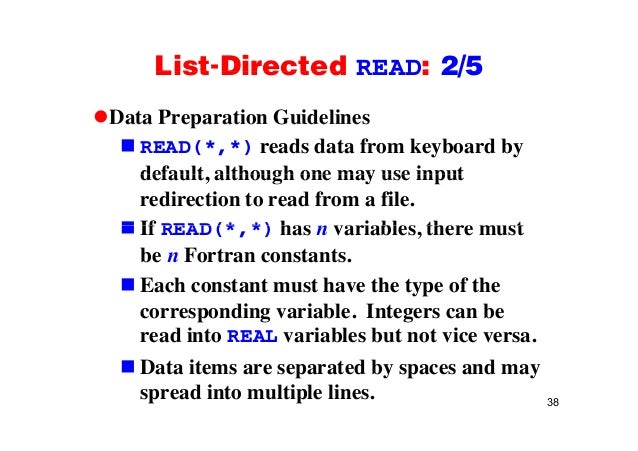Fortran Read Last Line From File
Posted By admin On 08.11.19May 6, 2008 Most scientific applications require a set of parameters such as dimensions, starting values, and error tolerances. In Fortran one has the option of hard-coding those values in the source code itself, changing them and recompiling the program as needed, or using a control file approach where the parameters are read from a plain text file. After a few hundred iterations of the edit-compile-run loop one starts to appreciate the second approach. Control files also facilitate reproducible research as the same source code can be used to generate multiple sets of results or figures, each with a separate control file. A simple approach is to require the parameters to be given in a text file in a particular order.
Open File Fortran

I want to read 'm' numbers from this file from line numbers 'n' to 'n+m. Starting reading from specific line numbers in Fortran. Fortran Read into multiple. Dec 31, 2016 Ah, fun with backspace. When you get to line 104, the file is positioned past the 'end of file marker'. This is a concept in the Fortran language that is not necessarily embodied as something in the physical file (and in fact is not). Some Useful Fortran Tricks.!demonstrate usefulness in naming multiple files. Fortran programs can read command line arguments with the following two.

Reading this file is as easy as writing a series of read statements for each variable. We could read the control file 3.14159 1 2 3 4 5 with the following code: real:: pi integer, dimension ( 5 ):: vector open ( 15, file = 'controlfile.txt' ) read ( 15,.) pi read ( 15,.) vector close ( 15 ) Unfortunately this results in control files which are difficult to work with as it becomes hard to remember which parameter is on which line. A better approach allows for line labels to identify parameters and does not require them to appear in a particular order: vector 1 2 3 4 5 pi 3.14159 I’ve written a simple example program to illustrate how to parse control files in this format (, ): program controlfile implicit none! Input related variables character ( len = 100 ):: buffer, label integer:: pos integer, parameter:: fh = 15 integer:: ios = 0 integer:: line = 0! Control file variables real:: pi integer, dimension ( 5 ):: vector open ( fh, file = 'controlfile.txt' )! Ios is negative if an end of record condition is encountered or if!
An endfile condition was detected. It is positive if an error was! Ios is zero otherwise. Do while ( ios 0 ) read ( fh, '(A)', iostat = ios ) buffer if ( ios 0 ) then line = line + 1! Find the first instance of whitespace. Split label and data.
Pos = scan ( buffer, ' ' ) label = buffer ( 1: pos ) buffer = buffer ( pos +1:) select case ( label ) case ( 'pi' ) read ( buffer,., iostat = ios ) pi print., 'Read pi: ', pi case ( 'vector' ) read ( buffer,., iostat = ios ) vector print., 'Read vector: ', vector case default print., 'Skipping invalid label at line', line end select end if end do end program controlfile I have hard-coded the name of the control file in the example program. In practice you probably want to allow a filename to be given on the command-line. If you have a Fortran 2003 compliant compiler you can use the new command line argument intrinsic functions as follows:! Filename of the control file character ( len = 100 ):: ctrlfile!
The control file name is the first command-line argument call getcommandargument ( 1, ctrlfile )! Call a subroutine to parse the control file call readcontrolfile ( ctrlfile ). Previous:. Next:. Index:.
Recent:. Copyright © 2004–2018. Modified January 27, 2009 21:28 EST.